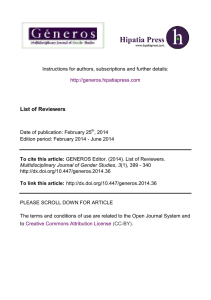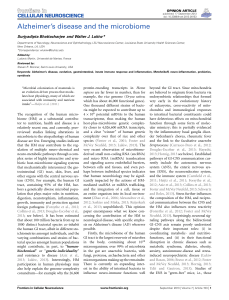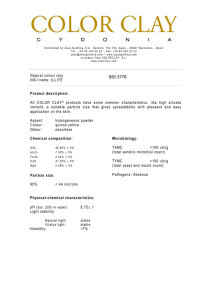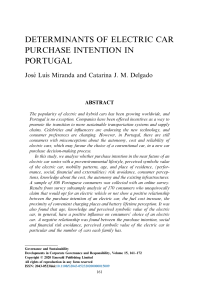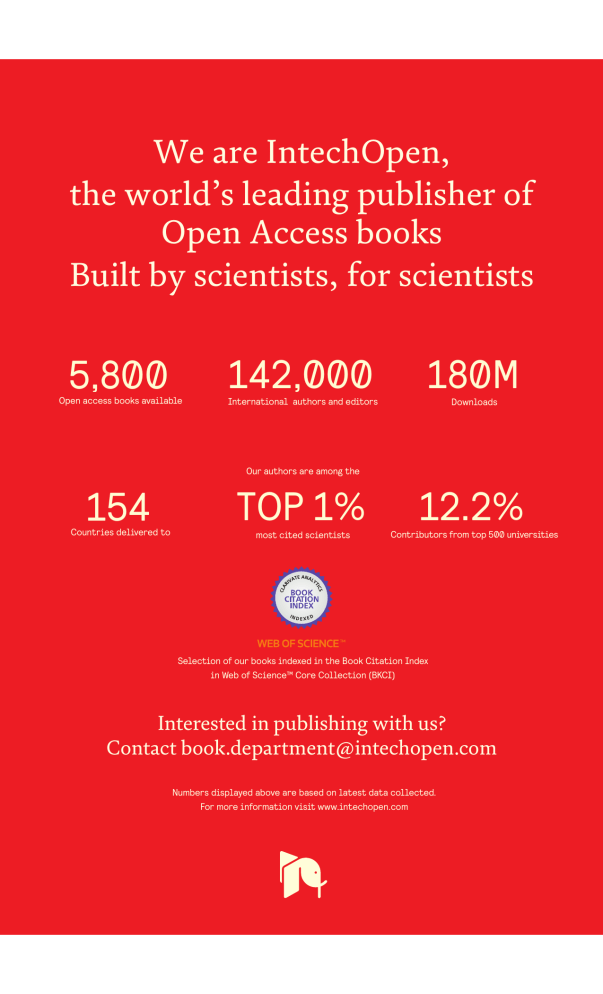
We are IntechOpen, the world’s leading publisher of Open Access books Built by scientists, for scientists 5,800 142,000 180M Open access books available International authors and editors Downloads Our authors are among the 154 TOP 1% 12.2% Countries delivered to most cited scientists Contributors from top 500 universities Selection of our books indexed in the Book Citation Index in Web of Science™ Core Collection (BKCI) Interested in publishing with us? Contact [email protected] Numbers displayed above are based on latest data collected. For more information visit www.intechopen.com Chapter Rheological Perspectives of Clay-Based Tailings in the Mining Industry Ricardo I. Jeldres and Matías Jeldres Abstract The mining industry faces a significant problem in regions with water scarcity and has had to put in place new strategies to preserve its environmental and economic sustainability. An attractive option in recent years has been the direct use of seawater, avoiding the construction of reverse osmosis plants to desalinate. But, some operational complexities are the subject of discussion and research for engineers; for example, the difficulties by the high presence of complex gangues like clays and the location of the plants, far from the coast and at high altitude. The latter requires high investments in pumping, the only option in some cases. In this scenario, it is imperative to improve the efficiency of water use and advance to effective closures of water circuits. A critical stage is the thickening that allows water to be recovered from the tailings, reusing it in upstream operations. However, the performance of the tailings management is usually limited by the rheological properties of the thickened slurries, which impact on the discharge from the underflow of the thickeners, pumping energy costs, disposal on the tailings storage facilities (TSFs). This text describes the consequences caused by a saline medium on the rheological properties of clay-based tailings, analysing scenarios that allow tackling this operation. Keywords: rheology, clays, seawater, thickening, tailings, water recovery 1. Introduction On a global scale, mining is a relatively small consumer of water compared to the agricultural or forestry industry, however, it can generate a significant social and environmental impact, mainly in those companies located in arid regions as occurs in numerous operations in Chile, Australia, and South Africa [1, 2]. The industry has made great efforts to optimise the use of water where the proper tailings management is crucial towards advance to the effective closure of water circuits. Essential aspects are the quantity and quality of water recovered in thickeners, solid concentration of the thickened slurries, drainage capacity of the underflow in the lower cone of thickeners, the energy and water required for transport, and the disposal strategies in the tailings storages facilities (TSFs). The rheological properties largely determine the performance of all the aspects previously mentioned and in many cases, it defines the success that the design of a concentrator plant will have [3–5]. 1 Clay Science and Technology 2. Tailings management The different types of thickening technologies mostly establish the amount of water that can be extracted from the tailings, and hence the characteristics of the pulps that are transported to the TSFs. In the copper industry, conventional and high rate thickeners generate pulps between 50 and 60 wt% that have low yield stress (<40 Pa), while high-density and paste thickeners can make pulps over 65 wt% with yield stresses over 100 Pa [6, 7]. The thickened pulps are subsequently transported, usually by pumping to the tailings storage facilities (TSFs) [7]. The design of a tailings circuit should adequately consider the three stages involved (see Figure 1). i. Performance in water recovery in solid-liquid separation stages (thickening mainly); ii. Pumping of thickened tailings, whose costs fluctuate depending on the characteristics of both the pulps (rheological properties) and geography of the plants. In some instances the thickeners are located at a higher altitude than the TSFs, and gravity might assist the pumping. In contrast, on other cases the cost per transport may be decisive, especially when the distances are too long, the tailings have high density, or there are no gravitational advantages; iii. Disposal methods and dewatering in TSFs, which primarily depend on the rheological behaviour of the slurries that consequently are a result of the thickening technologies. Among the most advanced technologies to promote tailings dewatering are paste thickeners (Figure 2(a)). These equipment have a much higher lateral height than the other types of thickeners, a higher inclination of the discharge cone (30-45%), and the product is a tailing with a maximum concentration of solids. The pulps can Figure 1. Schematic representation of the stages involved in tailings management. 2 Rheological Perspectives of Clay-Based Tailings in the Mining Industry DOI: http://dx.doi.org/10.5772/intechopen.93813 Figure 2. (a) Paste thickener, (b) depositing of a tailing from a paste thickener. reach solids concentrations near to 70 wt%, maximising the tailings dewatering, and facilitating their disposal in the TSFs (Figure 2(b)). Here comes the importance of the rheological properties of the slurries, since their pumping could incur excessive energy costs. 3. Rheological characterisation The traditional method to characterise the rheological behaviour of tailings is through flow curves that are fitted to viscoplastic models such as Bingham or Herschel-Bulkley. Then, the yield stress is derived, which is widely used to describe, design, and control tailings processes in pipelines and beds. The accuracy of such measurements is controversial, and great care must be taken in some systems where precise equilibrium data is challenging to obtain (that is common for mining tailings). Nguyen and Boger [8] adopted the static yield stress vane measurement that is simple and has become widely used. Fisher et al. [9] later concluded that while the rough surfaces of the cup and bob geometries can be used successfully, infinite cup vane geometry alleviates all wall effects and it is a suitable method of determining yield stress and flow at steady-state behaviour of strongly aggregated particle suspensions. Reograms are graphical representations of the response of the shear stress to variations in the angular strain rate, considering a material (suspension, in this case) between two parallel planes where one is moved, and the other remains immobile. The resolution of the Navier-Stokes equations, which describe the movement of the fluid, is simplified to an analytical form, taking care that the inertial forces are small compared to the viscous forces. Consequently, the viscometric flow is characterised by simple configurations in which the only relevant component of the stress tensor is the pure shear. Therefore the inverse problem for the viscosity can be solved directly by fitting the experimental measurements of some physical magnitude, as the torque M. For the accurate description of the empirically obtained rheograms, it is necessary to consider the boundary conditions that are used to solve the Navier-Stokes equations in their simplified form. This means that particle sedimentation, the appearance of secondary flows (e.g. Taylor vortices) and phenomena such as wall slip should be avoided. 3 Clay Science and Technology Figure 3. Representation of Taylor vortices in a Couette geometry. 3.1 Taylor’s vortices Some low-viscosity slurries may involve a secondary flow driven by the inertia of the sample, forming a phenomenon called Taylor vortices (see Figure 3). When this happens, it is common for rheograms to observe a false increase in rheological properties or even shear thickening (dilatant) behaviours. The appearance of the vortices is anticipated by the Taylor number (T), which in the case of concentric cylinders with internal cylinder rotation is described by the Eq. (1): 2 4 a1 ( a2 − a1 ) T= 2 ⋅ ⋅ 2 a1 a2 1 − a 2 2 ρ ⋅ω ⋅ η (1) Where: • a1 inner radius • a2 outer radius • ρ liquid density • ω rotational speed of the inner cylinder in rad/s • η fluid viscosity 3.2 Wall-slip The obtaining of rheological parameters is based on the Navier-Stokes equation, whose expression is given by the Eq. (2): ∂ 1 ∂ ( rυθ ) = 0 ∂r r ∂r η (2) Obtaining an analytical solution to the expression requires a series of assumptions, for example, that the fluid moves in laminar flow, with streamlines moving in a radial direction, around the inner cylinder as shown in Figure 3. In particular, the fluid layer located in the contours is assumed to move at the same speed as the walls 4 Rheological Perspectives of Clay-Based Tailings in the Mining Industry DOI: http://dx.doi.org/10.5772/intechopen.93813 of the inner and outer cups. However, it is common for a wall slip phenomenon to occur, which is defined as the difference between the speeds of the wall relative to that of the fluid in the wall. This phenomenon is caused by a thin layer of solution that forms on the walls and creates a wrong decrease in rheological properties. Obtaining the right rheological behaviour needs performing a rheogram correction, based on measurements made with geometries of different dimensions and shapes. A method proposed by Yoshimura and Prud’homme [10], expects only two measurements, using geometries with different gaps but with the same ratio between the radii of the cup and the internal cylinder. According to this method, the slip velocity which corresponds to the stress τ ∗ from two angular velocity can be described as: κ Ù1 −Ù2 us (τ ∗ ) = κ +1 1 − 1 R1 R2 (3) Where: • us (τ ∗ ), slip velocity at the cup or bob surface • κ , cup/bob ratio = Ri / R0 • Ù, angular velocity Figure 4 shows the typical result of preparing measurements with different Ù ranges on each device. Yoshimura and Prud’homme [10] validated the proposed method with 1.9 wt% clay suspensions, measuring on different Couette devices. Figure 4 also shows the experimental measurements and the corrected rheogram value. Commonly, concentrated tailings show a non-Newtonian behaviour where they have an elastic limit. The yield stress, τy, is the critical shear stress that must be overcome before irreversible deformation and flow can occur. The yield stress is an engineering reality, although the rheology community debates hard about its Figure 4. Angular velocity (Ω) vs. bob stress for a 1.9 wt% clay suspension measured on different Couette devices. Also shown is the angular velocity corrected for wall slip (Ωf ) vs. bob stress (adapted from Yoshimura and Prud’homme [10]). 5 Clay Science and Technology real existence [11, 12]. The truth is that its estimation is a routine practice to define control strategies for the management of mine tailings [13–15]. Yield stress depends on chemical interactions between particles, size distribution, and pulp density. This last aspect is critical in the search to maximise water recovery; however, the relationship between density and yield stress follows an exponential law where small changes in the percentage of solids lead to a significant rise in the value of yield stress. A schematic representation of the implications of thickening technology on the density and rheological behaviour of the pulps is shown in Figure 5. For example, when the underflow is thickened to too high concentration, the energy cost per pumping can reach prohibitive values, and operators may be required to dilute the thickened tailings, which means sacrificing water that could have been recirculated to upstream operations. In the last time, some studies have integrated additional parameters in the discussion, especially analysing the viscoelastic behaviour of the pulps. Although to date there are no publications that directly use of viscoelastic parameters for the design of tailings circuits, their knowledge has allowed obtaining more information on the strength of the particle networks that make up the mineral slurries [16–18]. The behaviour of the sample is described through a viscous component, represented by the storage modulus (G′), and an elastic part, represented by the loss modulus (G″) [19]. The viscoelastic modulus can be obtained using dynamic oscillatory rheology methods, which are carried out by subjecting the sample to an oscillatory deformation γ ( t ) = γ 0 sin (ω t ) , obtaining the resulting stress as a function of time τ ( t ) = γ 0 ( G′ (ω ) sin (ω t ) + G″ (ω ) cos (ω t ) ) . G′ is a measure of the material’s stored energy and is therefore related to molecular events of an elastic nature, while G″ indicates the energy dissipated as heat, associated with viscous molecular events. Lin et al. [18] analysed the structural changes of kaolinite particle junctions concerning the pH and concentration of solids in the pulp. Using small-amplitude oscillatory shear (SAOS) tests, the authors concluded that the gelation by attractive interactions in low-mass fractions changes to gelation by face-to-face interactions by increasing the particle mass fraction. Gelation by face-to-face interactions is stabilised by the repulsive electrostatic force between the faces of the disk-shaped particles. Based on a DLVO theory that is based on attractive forces between Figure 5. Relationship between the type of thickener and properties of the underflows (solid concentration and yield stress). 6 Rheological Perspectives of Clay-Based Tailings in the Mining Industry DOI: http://dx.doi.org/10.5772/intechopen.93813 particles, a modified model has been developed based on the repulsive electrostatic force between the faces of the platelets. 4. Rheological behaviour in saline environments The current tailings dewatering challenges within the mining industry are the upstream use of low-quality water (like seawater) in processing and complex gangues like clays [20–22]. In the first case, the behaviour of the pulps in a highly saline environment must be faced, which is complex from a scientific point of view, since salinity significantly alters the interactions between the particle’s surfaces, bringing important consequences in the rheological properties. They are strongly related to salinity and the type of salt [23]. For example, Reyes et al. [24] studied the rheological behaviour of magnetite tailings without flocculation, using mixtures of freshwater with seawater in different proportions. The authors were able to explain their findings in terms of electrostatic interactions, since they related the value of yield stress with the magnitude of the zeta potential, following the recommendation proposed two decades ago by Johnson et al. [25]. However, it should be noted that in complex saline systems, like seawater, there are many ions of different nature interacting simultaneously. In this case, the divalent cation speciation and the maker/breaker type may have an important role. For example, the formation of solid magnesium complexes at high pH (pH < 10.5) can cause the rheological properties of a quartz suspension to be reduced [26]. Jeldres et al. [27] analysed the viscoelastic behaviour of quartz suspensions prepared in monovalent brines. As seen in Figure 6(a), there is a direct relationship between the size of the cations and the yield stress. The authors explained that silica has a more significant trend to agglomerate in the presence of larger ions like K+, forming stronger particle networks compared to smaller salts like Na+ and Li+. According to fundamental studies, the surface of the silica would present a breakerlike behaviour [28], having a higher affinity with species of the same nature as is observed in Figure 6(b), where the amount of adsorbed cation increases for larger sizes, following the order Li+ < Na+ < Cs+. In the case of clays, the surface would have a higher affinity for water molecules, exhibiting a maker-like behaviour [29]. Clays are a consistent focus of research because they negatively impact almost all processes in the mining sector, including leaching, flotation, pulp transport, thickening, etc. [16, 30, 31]. These phyllosilicates can be classified according to their swelling (e.g. sodium montmorillonite) and non-swelling (e.g. kaolinite) character. This classification is made according to the response of the particles when they come into contact with water, being able to preserve their structure or increase their Figure 6. Effect of the type of salt on (a) yield stress of quartz suspensions; (b) adsorption of the monovalent cation on the quartz surface (adapted from Jeldres et al. [27]). 7 Clay Science and Technology apparent volume in solution. Kaolinite (Al2Si2O5(OH)4) (Figure 7) is composed of an octahedral sheet of aluminium hydroxide and a tetrahedral sheet of silica which are joined to form a basic 1:1 repeating unit. This clay has two crystallographically different surfaces: the faces that are negatively charged, and the edges, which vary their charge (anionic or cationic) depending on the pH that arises from the protonation or deprotonation of the aluminium (Al▬OH) and silanol groups (Si▬OH) in the exposed planes with hydroxyl termination. Due to their anisotropic structure and charge properties, clay sheets can form different types of interactions: face-toface (FF), edge-to-edge (EE) and edge-to-face (EF). Montmorillonite (Figure 8) is composed of an octahedral alumina sheet and two tetrahedral silica sheets that join to form a basic unit of repeating layers in a 2:1 ratio [32]. The central layer contains octahedral coordinated Al and Mg in the form of oxides and hydroxides and is surrounded by two external layers formed by tetrahedral coordinated silicon oxides. This clay has high chemical stability, a large surface Figure 7. Representation of the kaolinite structure. The green sheet indicates the tetrahedral layer of silicon (T) and the yellow sheet corresponds to the octahedral layer of alumina (O). Figure 8. Representation of the sodium montmorillonite structure. The green sheet indicates the tetrahedral layer of silicon (T) and the yellow sheet corresponds to the octahedral layer of alumina (O). 8 Rheological Perspectives of Clay-Based Tailings in the Mining Industry DOI: http://dx.doi.org/10.5772/intechopen.93813 area and a top ion exchange capacity as a result of its weakly bound octahedral sheets. Unlike kaolinite, montmorillonite has a high capacity to swell in the presence of freshwater as a result of water molecules entering the middle of the layers [33]. In freshwater, the swelling effect of montmorillonite is more significant than in saline medium. This is because the cations being in saline water helps to neutralise the negative charges of the interlayer layers of the clay, reducing its electrostatic repulsion and therefore its separation distance [34–36]. This prevents the entrance of water molecules into the clay, notably impacting its swelling [37]. The high level of particles’ swelling in freshwater implies an increase in the apparent volume concentration, which generates a considerable increase in the rheological properties of the slurries [38]. However, this characteristic is strongly influenced by the chemical nature of the water and the presence of ions in solution [39]. The chemical differences in the surface cause significant changes in the rheological properties of the pulps. For this reason, clay suspensions are exposed to dramatic changes concerning the pH of the suspension, mainly due to changes in electrostatic forces on surfaces. At low pH, there are anionic (faces) and cationic (edges) zones that generate attractive strong bonds between the particles, which clump together to form a “house of cards” structure. However, increasing the pH intensifies a greater electrostatic repulsion, causing the particles to disperse and the suspension to be more stable. The rheological consequences regarding pH have been widely addressed in the literature. Clays of 1:1 structure such as kaolinite generally show a behaviour that is decreasing concerning pH (Figure 9). In contrast, swelling clays such as montmorillonite have demonstrated the marked presence of a maximum at pH around 4 (Figure 10). The electrostatic attraction between the faces and edges is the primary mechanism that gives strength to the bonds between clay particles. For this reason, the presence of salt causes a reduction in electrical charges, resulting in lower viscosity and yield stress. Figure 11 shows the impact of adding 0.1 M of electrolytes to the suspension. The rheogram curve shifts downwards when salt is present, however, the values strongly depends on the type of cation, where divalent cations generate a greater impact as they are more efficient in compressing the double electrical layer. The effect at alkaline conditions is different. The slurries in freshwater have low rheological parameters but the compression of the double-layer may favour the particles’ aggregation, forming both hydrogen and cationic bonds. The result is that the rheological properties increase in a saline medium like seawater; therefore, the management of clay-based tailings may involve higher energy costs. In this sense, it Figure 9. Relationship between pH and yield stress for crown kaolin slurries at varied solid concentration (adapted from Au and Leong [40]). 9 Clay Science and Technology Figure 10. Relationship between pH and yield stress for Na-montmorillonite slurries at varied solid concentration (adapted from Au and Leong [40]). Figure 11. Comparison between the effects of monovalent and divalent electrolytes on the flow curves of bentonite 1. Suspension: 8% bentonite in 0.1 M electrolyte solution (adapted from Abu-Jdayil [41]). is necessary to find strategies to obtain pulps with rheological properties that simplify their transport. Contreras et al. [38] studied the effect of NaCl concentration on the rheological properties of synthetic tailings composed of mixtures of quartz and clays. Considering that the pulps were prepared at natural pH, it was found that salinity lowered the yield stress, as shown in Figure 12. 5. Chemical reagents The permanent challenge for tailings management is to be able to manipulate their rheological properties, according to the plant bases. When seeking to facilitate the discharge of the tailings from the thickeners and to reduce the water and energy consumption involved in their transport by pumping, it is needed to find methods to reduce the values of yield stress and viscosity. Li et al. [42] used polycarboxylate copolymers synthesised in the treatment of kaolin suspensions. The results revealed the high capacity of the polymers to reduce the viscosity, due to the dispersion of the particles caused by steric and electrostatic effects, by increasing the anionic charge of the particles. Du et al. [43] enlarged the electrostatic repulsion between bentonite particles by adding multiple charged phosphate-based reagents. The authors could reduce the 10 Rheological Perspectives of Clay-Based Tailings in the Mining Industry DOI: http://dx.doi.org/10.5772/intechopen.93813 yield stress to zero when it was a tetravalent or higher valence (see Figure 13). The results were explained by the changes in the electrostatic interactions, where the salts with higher valence were more pragmatic in reducing the negative zeta potential (Table 1). However, when interactions occur in a highly saline medium, such as seawater, it is challenging to suggest strategies that drive an electrostatic repulsion since the high concentration of counter ions reduces the electrical double layer, making electrostatic changes less significant. For this reason, Robles et al. [44] recommended that the most efficient reagents are those that cause steric stabilisation of the Figure 12. Effect of the salinity on the yield stress of clay suspensions: (a) pure kaolin; (b) kaolin/Na-bentonite, 50/50; (c) pure Na-bentonite (adapted from Contreras et al. [38]). Figure 13. Effect of phosphate-based additives on the yield stress of bentonite slurries (adapted from Du et al. [43]). 11 Clay Science and Technology ( NaPO ) None PO43− P3O93− P2O74− 5− P3O10 Ζ (mV) −44 −48 −46.4 −64.4 −64.9 −66.1 pH 9.0 8.4 7.7 9.9 9.0 7.3 3 17 Table 1. The effect of 10 dwb% phosphate-based additives on the zeta potential and pH of 7 wt% bentonite slurries (adapted from Du et al. [43]). Figure 14. Herschel-Bulkley parameters (yield stress and flow index) of kaolin pulp in seawater at pH 8 with varied sodium polyacrylate concentrations (Robles et al. [44]). particles. The authors studied the influence of sodium polyacrylate of low molecular weight on the performance and viscoelasticity of kaolin pulps in seawater. It was shown that the reagent could reduce the strength of the bonds between the particles through steric stabilisation, considerably lowering the yield stress (Figure 14). It was interesting that this polymer of low molecular weight provides promising results in a highly saline medium since the main reports in the literature have given its efficiency to the induction of higher anionic charges on the surfaces [45, 46]. 6. Outlook Tailings management in saline environments continues to be a challenging issue for plant design and operation, especially when significant clay content appears. Numerous factors enter the discussion, such as water quality, mineralogy (the type of clay), legal regulations, availability of water resources, etc. The need to improve the efficiency of this operation has increased in recent years, which has attracted greater scientific interest. Notable improvements have emerged from a technological point of view, in which the market offers increasingly robust equipment. That allows significant amounts of water to be extracted from the tailings and recycle them to upstream operations, with economic, environmental, and social benefits considering that many industries compete with neighbouring communities for disposing of the water resource. So reducing the water make-up means that more water would be available to the population. Acknowledgements The authors thank ANID/Fondecyt/11171036 and Centro CRHIAM Project ANID/FONDAP/15130015. 12 Rheological Perspectives of Clay-Based Tailings in the Mining Industry DOI: http://dx.doi.org/10.5772/intechopen.93813 Conflict of interest The authors declare no conflict of interest. Author details Ricardo I. Jeldres1* and Matías Jeldres2 1 Department of Chemical Engineering and Mineral Processing, University of Antofagasta, Antofagasta, Chile 2 Faculty of Engineering and Architecture, Arturo Prat University, Antofagasta, Chile *Address all correspondence to: [email protected] © 2020 The Author(s). Licensee IntechOpen. This chapter is distributed under the terms of the Creative Commons Attribution License (http://creativecommons.org/licenses/ by/3.0), which permits unrestricted use, distribution, and reproduction in any medium, provided the original work is properly cited. 13 Clay Science and Technology References [1] Northey, S. A.; Mudd, G. M.; [9] Fisher, D. T.; Clayton, S. A.; Werner, T. T.; Jowitt, S. M.; Haque, N.; Yellishetty, M.; Weng, Z. The exposure of global base metal resources to water criticality, scarcity and climate change. Glob. Environ. Chang. 2017, 44, 109-124, doi:10.1016/j. gloenvcha.2017.04.004. Boger, D. V.; Scales, P. J. The bucket rheometer for shear stress-shear rate measurement of industrial suspensions. J. Rheol. (N. Y. N. Y). 2007, 51, 821-831, doi:10.1122/1.2750657. [2] Cisternas, L. A.; Gálvez, E. D. The use of seawater in mining. Miner. Process. Extr. Metall. Rev. 2018, 39, 18-33, doi:10.1080/08827508.2017.1389 729. [3] Boger, D. V. Rheology of slurries and environmental impacts in the mining industry. Annu. Rev. Chem. Biomol. Eng. 2013, 4, 239-257, doi:10.1146/ annurev-chembioeng-061312-103347. [4] Nguyen, Q. D.; Boger, D. V. Application of rheology to solving tailings disposal problems. Int. J. Miner. Process. 1998, 54, 217-233, doi:10.1016/ S0301-7516(98)00011-8. [5] Boger, D. V. Rheology and the Minerals Industry. Miner. Process. Extr. Metall. Rev. 2000, 20, 1-25, doi:10.1080/08827509908962460. [6] Watson, A. H.; Corser, P. G.; [10] Yoshimura, A.; Prud’homme, R. K. Wall slip corrections for couette and parallel disk viscometers. J. Rheol. (N. Y. N. Y). 1988, 32, 53-67, doi:10.1122/1.549963. [11] Hartnett, J. P.; Hu, R. Y. Z. Technical note: The yield stress—An engineering reality. J. Rheol. (N. Y. N. Y). 1989, 33, 671-679, doi:10.1122/1.550006. [12] Barnes, H. A.; Walters, K. The yield stress myth? Rheol. Acta 1985, 24, 323326, doi:10.1007/BF01333960. [13] de Kretser, R.; Scales, P. J.; Boger, D. V. Improving clay-based tailings disposal: Case study on coal tailings. AIChE J. 1997, 43, 1894-1903, doi:10.1002/aic.690430724. [14] Sofrá, F.; Boger, D. V Environmental rheology for waste minimisation in the minerals industry. Chem. Eng. J. 2002, 86, 319-330, doi:10.1016/ S1385-8947(01)00225-X. Garces-Pardo, E. E.; López-Christian, T. E.; Vandekeybus, J. A comparison of alternative tailings disposal methods — the promises and realities. In Mine Waste 2010 -A.B. Fourie and R.J. Jewell (eds); Perth, 2010; pp. 499-514. [15] Adiansyah, J. S.; Rosano, M.; [7] Wang, C.; Harbottle, D.; Liu, Q.; [16] McFarlane, A. J.; Bremmell, K. Xu, Z. Current state of fine mineral tailings treatment: A critical review on theory and practice. Miner. Eng. 2014, 58, 113-131, doi:10.1016/j. mineng.2014.01.018. [8] Dzuy, N. Q.; Boger, D. V. Direct yield stress measurement with the vane method. J. Rheol. (N. Y. N. Y). 1985, 29, 335-347, doi:10.1122/1.549794. 14 Vink, S.; Keir, G. A framework for a sustainable approach to mine tailings management: disposal strategies. J. Clean. Prod. 2015, 108, 1050-1062, doi:10.1016/j.jclepro.2015.07.139. E.; Addai-Mensah, J. Optimising the dewatering behaviour of clay tailings through interfacial chemistry, orthokinetic flocculation and controlled shear. Powder Technol. 2005, 160, 27-34, doi:10.1016/j.powtec.2005.04.046. [17] Cruz, N.; Forster, J.; Bobicki, E. R. Slurry rheology in mineral processing unit operations: A critical review. Can. Rheological Perspectives of Clay-Based Tailings in the Mining Industry DOI: http://dx.doi.org/10.5772/intechopen.93813 J. Chem. Eng. 2019, 97, 2102-2120, doi:10.1002/cjce.23476. [18] Lin, Y.; Phan-Thien, N.; Lee, J. B. P.; Khoo, B. C. Concentration dependence of yield stress and dynamic moduli of kaolinite suspensions. Langmuir 2015, 31, 4791-4797, doi:10.1021/acs. langmuir.5b00536. [19] Barnes, H.A., Hutton, J.F., Walters, K. An introduction to rheology. Rheology Series (NL). Vol. 3.; Elsevier Science, Ed.; 1989; ISBN 9781493302611. [20] Hernández, P.; Taboada, M.; Herreros, O.; Graber, T.; Ghorbani, Y. Leaching of chalcopyrite in acidified nitrate using seawater-based media. Minerals 2018, 8, 238, doi:10.3390/ min8060238. [21] Jeldres, R. I.; Uribe, L.; Cisternas, L. A.; Gutierrez, L.; Leiva, W. H.; Valenzuela, J. The effect of clay minerals on the process of flotation of copper ores - A critical review. Appl. Clay Sci. 2019, 170, 57-69, doi:10.1016/j. clay.2019.01.013. [22] Liu, D.; Edraki, M.; Fawell, P.; Berry, L. Improved water recovery: A review of clay-rich tailings and saline water interactions. Powder Technol. 2020, 364, 604-621, doi:10.1016/j. powtec.2020.01.039. [23] Jeldres, R. I.; Piceros, E. C.; Wong, L.; Leiva, W. H.; Herrera, N.; Toledo, P. G. Dynamic moduli of flocculated kaolinite sediments: effect of salinity, flocculant dose, and settling time. Colloid Polym. Sci. 2018, 296, 19351943, doi:10.1007/s00396-018-4420-x. [25] Johnson, S. B.; Franks, G. V.; Scales, P. J.; Boger, D. V.; Healy, T. W. Surface chemistry–rheology relationships in concentrated mineral suspensions. Int. J. Miner. Process. 2000, 58, 267-304, doi:10.1016/S0301-7516(99)00041-1. [26] Jeldres, M.; Piceros, E.; Robles, P. A.; Toro, N.; Jeldres, R. I. Viscoelasticity of quartz and kaolin slurries in seawater: Importance of magnesium precipitates. Metals (Basel). 2019, 9, 1120, doi:10.3390/met9101120. [27] Jeldres, R. I.; Piceros, E. C.; Leiva, W. H.; Toledo, P. G.; Quezada, G. R.; Robles, P. A.; Valenzuela, J. Analysis of silica pulp viscoelasticity in saline media: The effect of cation size. Minerals 2019, 9, 1-15, doi:10.3390/ min9040216. [28] Quezada, G. R.; Rozas, R. E.; Toledo, P. G. Molecular dynamics simulations of quartz (101)-water and corundum (001)-water interfaces: Effect of surface charge and ions on cation adsorption, water orientation, and surface charge reversal. J. Phys. Chem. C 2017, 121, doi:10.1021/acs. jpcc.7b08836. [29] Quezada, G. R.; Rozas, R. E.; Toledo, P. G. Ab initio calculations of partial charges at kaolinite edge sites and molecular dynamics simulations of cation adsorption in saline solutions at and above the pH of zero charge. J. Phys. Chem. C 2019, 123, 22971-22980, doi:10.1021/acs.jpcc.9b05339. [30] Castillo, C.; Ihle, C. F.; Jeldres, R. I. Chemometric optimisation of a copper sulphide tailings flocculation process in the presence of clays. Minerals 2019, 9, 582, doi:10.3390/min9100582. [24] Reyes, C.; Álvarez, M.; Ihle, C. [31] Ma, X.; Fan, Y.; Dong, X.; Chen, F.; Contreras, M.; Kracht, W. The influence of seawater on magnetite tailing rheology. Miner. Eng. 2019, 131, 363-369, doi:10.1016/j. mineng.2018.11.037. R.; Li, H.; Sun, D.; Yao, S. Impact of clay minerals on the dewatering of coal slurry: An experimental and molecularsimulation Study. Minerals 2018, 8, 400, doi:10.3390/min8090400. 15 Clay Science and Technology [32] Bergaya, F.; Theng, B.; Lagaly, G. [40] Au, P.-I.; Leong, Y.-K. Surface Handbook of clay science; 2006; chemistry and rheology of slurries of kaolinite and montmorillonite from different sources. KONA Powder Part. J. 2016, 33, 17-32, doi:10.14356/ kona.2016007. [33] Kozak, M.; Domka, L. Adsorption of the quaternary ammonium salts on montmorillonite. J. Phys. Chem. Solids 2004, 65, 441-445, doi:10.1016/j. jpcs.2003.09.015. [34] Gorakhki, M. H.; Bareither, C. A. Salinity effects on sedimentation behavior of kaolin, bentonite, and soda ash mine tailings. Appl. Clay Sci. 2015, 114, 593-602, doi:10.1016/j. clay.2015.07.018. [35] Zhou, Z. Swelling clays in hydrocarbon reservoirs: The bad, the less bad, and the useful; UNITAR International Conference on Heavy Crude and tar Sands; China National Petroleum Corporation: Petroleum Industry Press, 1998; [36] Zhang, J. F.; Zhang, Q. H.; Maa, J. P. Y. Coagulation processes of kaolinite and montmorillonite in calm, saline water. Estuar. Coast. Shelf Sci. 2018, 202, 18-29, doi:10.1016/j. ecss.2017.12.002. [37] Elmashad, M. E.; Ata, A. A. Effect of seawater on consistency, infiltration rate and swelling characteristics of montmorillonite clay. HBRC J. 2015, 12, 175-180, doi:10.1016/j.hbrcj.2014.12.004. [38] Contreras, S.; Castillo, C.; Olivera- [41] Abu-Jdayil, B. Rheology of sodium and calcium bentonite–water dispersions: Effect of electrolytes and aging time. Int. J. Miner. Process. 2011, 98, 208-213, doi:10.1016/j. minpro.2011.01.001. [42] Moreno, P. A.; Aral, H.; Cuevas, J.; Monardes, A.; Adaro, M.; Norgate, T.; Bruckard, W. The use of seawater as process water at Las Luces coppermolybdenum beneficiation plant in Taltal (Chile). Miner. Eng. 2011, 24, 852858, doi:10.1016/j.mineng.2011.03.009. [43] Du, M.; Liu, J.; Clode, P.; Leong, Y.-K. Microstructure and rheology of bentonite slurries containing multiplecharge phosphate-based additives. Appl. Clay Sci. 2019, 169, 120-128, doi:10.1016/j.clay.2018.12.023. [44] Robles, P.; Piceros, E.; Leiva, W. H.; Valenzuela, J.; Toro, N.; Jeldres, R. I. Analysis of sodium polyacrylate as a rheological modifier for kaolin suspensions in seawater. Appl. Clay Sci. 2019, 183, 105328, doi:10.1016/j. clay.2019.105328. Nappa, Á.; Townley, B.; Ihle, C. F. A new statistically-based methodology for variability assessment of rheological parameters in mineral processing. Miner. Eng. 2020, 156, 106494, doi:10.1016/j.mineng.2020.106494. [45] Labanda, J.; Llorens, J. Influence of [39] Dong, Y.; Li, H.; Fan, Y.; Ma, X.; Synthesis of sodium polyacrylate copolymers as water-based dispersants for ultrafine grinding of praseodymium zirconium silicate. Colloids Surfaces A Physicochem. Eng. Asp. 2018, 558, 591-599, doi:10.1016/j. colsurfa.2018.08.027. Sun, D.; Wang, Y.; Gao, Z.; Dong, X. Tunable dewatering behavior of montmorillonite suspension by adjusting solution pH and electrolyte concentration. Minerals 2020, 10, 293, doi:10.3390/min10040293. 16 sodium polyacrylate on the rheology of aqueous Laponite dispersions. J. Colloid Interface Sci. 2005, 289, 86-93, doi:10.1016/j.jcis.2005.03.055. [46] Huang, G.; Pan, Z.; Wang, Y.



